Development of external trade price indices - 1. quarter of 2008
Product Code: e-7232-08
Quarter-on-quarter comparison:
Export prices Q1 2008 compared to Q4 2007 decreased by 2.1% (in Q4 2007 by 3.2%). Import prices decreased by 2.4 % (in Q4 -2.6%).
In export prices the most marked decrease (-3.2%) was recorded in 'machinery and transport equipment' (especially road vehicles), 'chemicals and related products' and 'miscellaneous manufactured articles' both by 2.9%. Among groups most important in terms of weight prices in 'mineral fuels, lubricants and related materials' went up by 10.6% (especially coal) and in 'crude materials, inedible, except fuels' by 0.7% (especially metal scrap).
In import prices like in exports, the most marked drop was recorded in 'machinery and transport equipment' by 4.2% (mainly electrical equipment), 'miscellaneous manufactured articles' by 3.3% (especially wearing apparel and accessories). Price increase was recorded only in 'mineral fuels, lubricants and related materials' by 3.0% (mainly gas).
External trade price development was again widely affected by the CZK exchange rates to the leading foreign currencies.
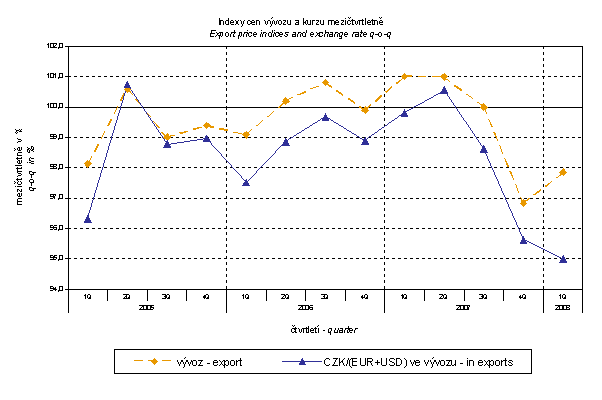
The q-o-q exchange rate index includes two most important currencies from the aspect of Czech external trade, i.e. EUR and USD; q-o-q indices of CZK exchange rates to these currencies were weighted by the weight which pertains to those currencies in the export price index.
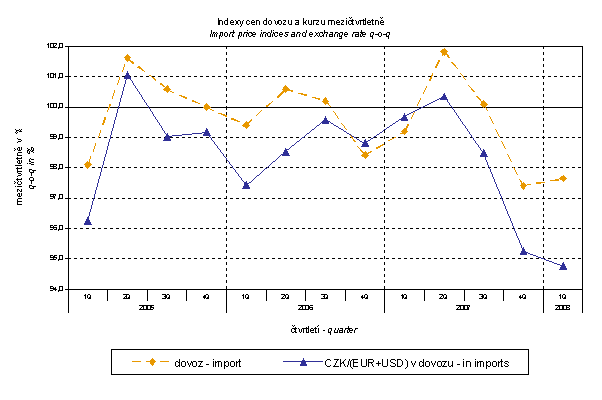
Similarly, when comparing with the q-o-q import price indices, q-o-q EUR and USD exchange rate indices were weighted by the weight which pertains to these currencies in the import price index.
Thus, it becomes clear that in both the import and export, the external trade prices have a strong relation to exchange rate impacts. This relation could naturally be even stronger in m-o-m comparison, however, also for the q-o-q index it is relatively strong as shown in graphs. It is rather logical conclusion because the contracts with foreign entities are, as a rule, signed for a longer period of time and the longer is the contract period, the stronger is the relation to exchange rates.
The graphs clearly show that more moderate strengthening of CZK in Q1 2008 resulted in more moderate drop of price indices. Lower drop rate of indices owed also to the fact that in Q1 usually new contracts for longer period of time are signed.
In Q1 2008, the value of terms of trade compared with Q4 2007 was 100.3 % (in Q4 2007 it was 99.4 %). In groups important in terms of weight positive values of terms of trade were recorded in 'mineral fuels, lubricants and related materials' 107.4%, 'machinery and transport equipment' 101.0% and 'miscellaneous manufactured articles' 100.4%. The lowest terms of trade value was recorded in 'chemicals and chemical products' 98.8%.
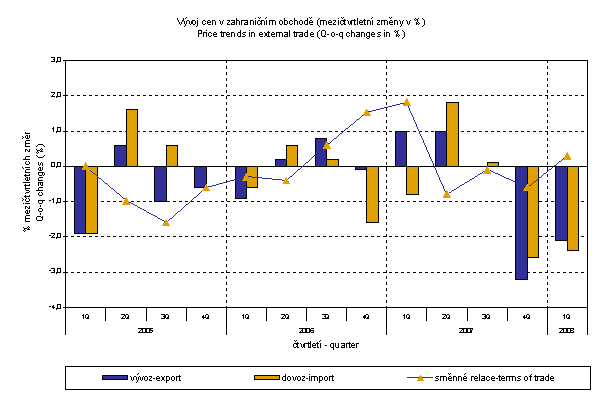
Year-on-year comparison:
In Q1 2008 export prices dropped by 4.3 % (in Q4 2007 by 1.2%). The prices thereby even deepened their drop reported for Q4 2007. Significant decrease was due mainly to continuing strong appreciation of CZK to EUR and USD. The biggest drop was recorded for prices in 'miscellaneous manufactured articles' by 6.6% and 'machinery and transport equipment' by 6.4% (especially telecommunication equipment and sound or video recording or reproducing apparatus) and prices in 'chemicals and related products' by 5.3% (especially dyeing materials). Among groups important in terms of weight increasing prices were recorded only in 'mineral fuels, lubricants and related materials' by 15.6% (particularly coal) and prices in 'food, beverages and tobacco' by 10.3% (mainly cereals and cereal products).
Import prices decreased in Q1 2008 by 0.3 % (in Q4 2007 by 1.5 %). The price drop was attributed especially also to a strong CZK exchange rate. The biggest price drops was recorded in 'machinery and transport equipment' by 7.1% (mainly general industrial machinery and equipment) and in 'miscellaneous manufactured articles' by 7.0%. Prices decreased also in 'manufactured good classified chiefly by material' by 4.6% and 'chemicals and related products' by 4.1%. Among groups important in terms of weight increasing prices were recorded only in 'mineral fuels, lubricants and related materials' by 18.6% (mainly petroleum and petroleum products).
Terms of trade reached in Q1 2008 y-o-y the value of 98.7 % (i.e. by 1.6 p.p. less than in Q4 2007). Y-o-y terms of trade showed negative values again after five quarters – see graph below. The lowest value was recorded in 'crude materials, inedible, except fuels' 95.3%. Terms of trade showed negative values also in 'mineral fuels, lubricants and related materials' 97.5% and in 'chemicals and related products' 98.7%. Positive values were reached in all other groups, among groups important in terms of weight positive values were recorded in 'miscellaneous manufactured articles' 100.4% and 'machinery and transport equipment' 100.8% and in 'manufactured goods classified chiefly by material'' 101.0%.
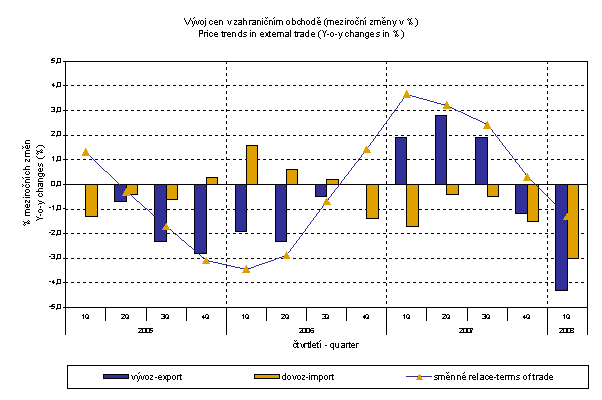
Beginning from Q4 2007 different price development of import and export prices was balanced again. As it was shown above, external trade prices are exposed to many effects, among other things, also to the CZK exchange rate to foreign currencies. This influence is important and often even decisive mainly in m-o-m expression; however, it is very significant in q-o-q comparison and markedly affects also the level of the year-on-year external trade price indices. In the last as well as in this quarter the CZK exchange rate recorded an exceptional growth. The development of quarterly y-o-y changes of exchange rates is clear from the graph below.
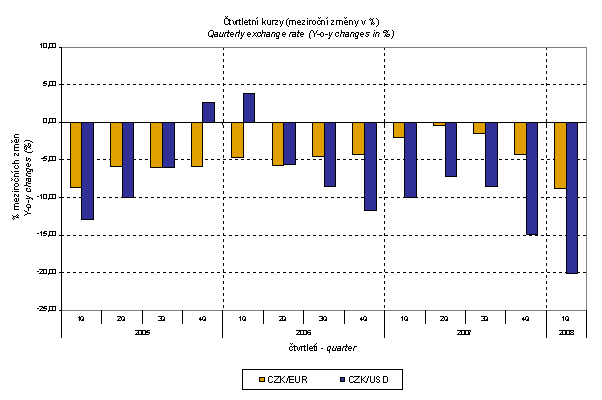
Year-on-year external trade price indices adjusted by exchange rate
The CZSO makes experimental calculations of monthly external trade price indices adjusted for exchange rate influence. The method used does not allow due to many practical reasons to make a 100% exchange rate adjustment (i.e. not all observed deals made in foreign currencies are for the needs of calculations of external trade price indices also reported as such – this share, however, makes only about 30 %). Nevertheless, it was verified that despite the increasing share of reporting in foreign currencies the currency basket remains basically constant. Thus, it can be stated that at the full exchange rate adjustment the differences between the published price indices and price indices that were adjusted would be even bigger.
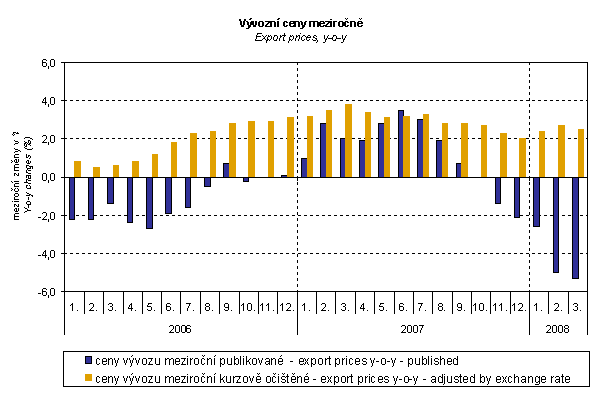
It is clear from the graph that the exchange rate was important also for export price indices. For the whole observed period except for June 2007 it decreased their amount (CZK was mostly strengthening to foreign currencies). In June the exchange rate increased the index due to weakening of CZK to EUR. After elimination of the exchange rate influence, export prices would have been increasing in all months in the period 2006 to 2008. In 2008 and especially in the last two months it is obvious how the strong exchange rate impacted the export price decrease.
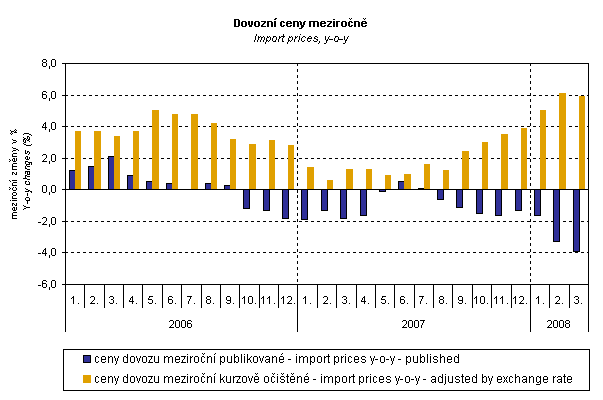
The graph above shows that the exchange rate markedly influenced also the import price indices. For the whole observed period it decreased their amount. After elimination of the exchange rate influence, export prices like import prices would have been increasing in all months of the period 2006 to 2008.
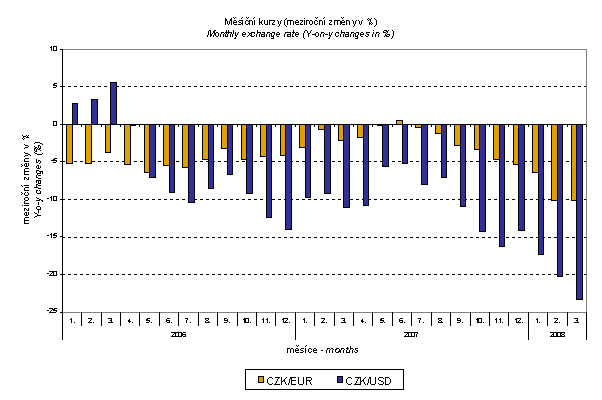
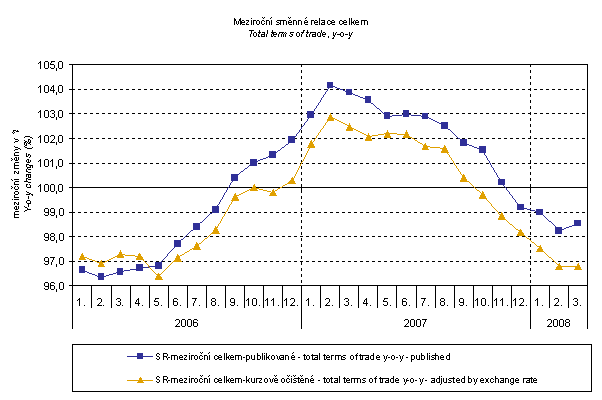
It is clear from the above graph that in the period from January 2006 to April 2006 the exchange rate influence decreased y-o-y terms of trade and from May 2006 to May 2008 the exchange rate influence increased terms of trade. This came from the fact that in currency basket the share of USD is bigger in imports than in exports. As it is clear from the graph Monthly Exchange Rates, in the period from January 2005 to April 2006 CZK strengthened to EUR and, at the same time, mostly weakened to USD. The graph also shows that even after the exchange rate influence elimination terms of trade would have been growing gradually from May 2006 to February 2007, however, this influence further intensified the growth of the exchange rate. From February 2007 save for June 2007 terms of trade were decreasing continuously until December 2007 when for the first time after six months they reached negative values. In March 2008 terms of trade began to grow modestly remaining, however, in negative values.

What are the other reasons of gradual drop of y-o-y terms of trade? The above graph shows groups showing more marked downward trend of terms of trade since 2007. This refers to 'miscellaneous manufactured articles' (mainly metaliferrous ores) where import prices grew faster than export prices but mainly to 'mineral fuels, lubricants and related chemicals (especially plastics). All these above mentioned groups, however, recorded a slow growth in March which contributed to the terms of trade modest increase as shown in the previous graph. How would the terms of trade value develop if the survey did not include 'mineral fuels, lubricants and related materials' ?
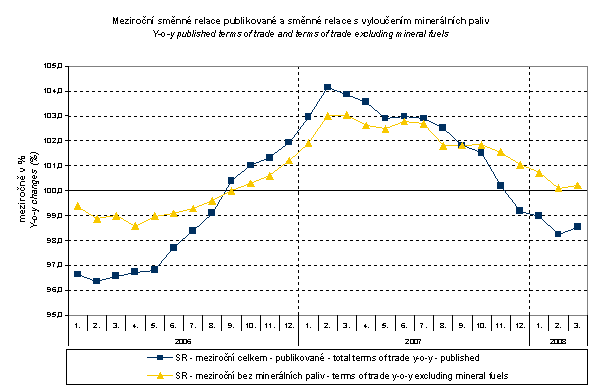
As it is clear from the graph 'mineral fuels, lubricants and related materials' decreased the total value of y-o-y terms of trade in the period from January to August 2006, from September 2006 to September 2007 they increased the terms of trade value and from October 2007 to March 2008 'mineral fuels, lubricants and related materials' again contributed to the terms of trade decrease. It is naturally linked to the price development in the world markets, especially prices of crude petroleum. Import prices which compared to export prices show higher share of crude materials respond more sensibly to price turbulences and as the prices of crude materials grow, terms of trade, as a rule, drop and, conversely, as the prices of crude material drop terms of trade grow.
Final table shows published not adjusted external trade price indices.
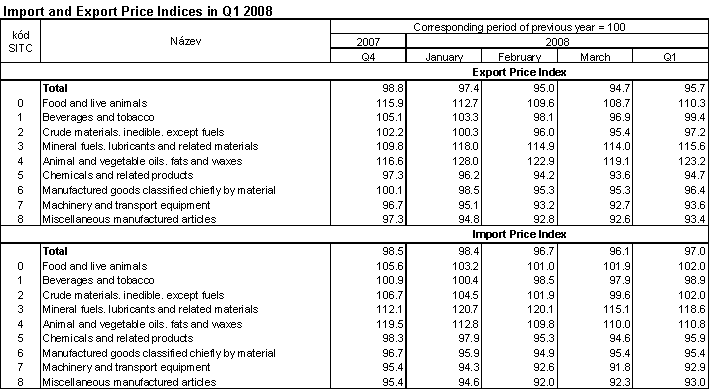
Prepared by: Vladimír Klimeš, Price Statistics Department
Director: Jiří Mrázek, phone 274 052 533
